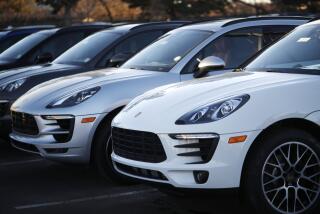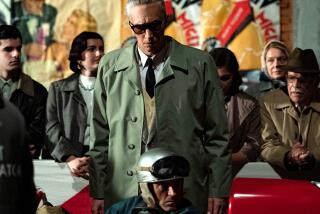A Maserati with Chrysler parts?
It is a mix of emotions only an Italian car can evoke.
Maserati’s all-new Ghibli and redesigned Quattroporte sedans thrill with all the lusty performance and high style expected from a brand with a loose connection to Ferrari. But — mama mia! — pity anyone hoping to roll down the window or turn on the lights in either of these Maseratis.
This poor soul encounters third-rate plastic pieces that Maserati grabbed out of Chrysler’s corporate parts bin. After a week of testing both the 2014 Ghibli and the 2014 Quattroporte, we were left more than a little frustrated by how a shoddy interior can foul an otherwise delizioso dish.
PHOTOS: Maserati’s Ghibli and Quattroporte sedans
Every automaker shares components across its various brands to cut costs. Jump in a $370,000 Bentley Mulsanne and the navigation screen will look conspicuously similar to the one in a $20,000 Volkswagen Jetta (Volkswagen Group owns both companies). In addition to saving everyone some money, automakers know that exactly zero people will test drive both cars and notice the sharing.
But somehow the practice seems more obvious in a Maserati.
The cheapo bits come from Chrysler by way of Fiat, the parent company of both brands. Fiat has decided that Maserati needs to grow its numbers to 50,000 vehicles sold worldwide in 2015. In 2013, it sold 15,400 cars. While that’s about the number of sales Mercedes logs in a long weekend, it was a 144% increase from the prior year for this venerated Italian brand.
Key to Maserati hitting that 2015 goal will be adding new models to a thin lineup. Until this new Ghibli, the brand offered only cars north of $100,000: the full-size Quattroporte sedan and the GranTurismo coupe and convertible.
The all-new Ghibli (GIB-lee, with a hard G) is a first step in the brand’s expansion. It’s aimed at high-end versions of BMW’s 5 and 6 Series sedans, Mercedes’ E-Class and CLS, and Audi’s A6/A7 siblings. This Maserati starts at $68,150 for the base rear-wheel-drive model, while a loaded, all-wheel-drive S Q4 model can top out around $100,000.
To build the Ghibli, Maserati grabbed the platform from the Quattroporte and cut nearly 7 inches off the wheelbase and almost a foot off the length.
Both versions of the Ghibli come with the same 3.0-liter, twin-turbocharged V-6. In the base model, it pumps out 345 horsepower and 369 pound-feet of torque. Jump up to the S Q4 version and, in addition to all-wheel drive, buyers get a retuned engine that makes 404 horsepower and 406 pound-feet of torque.
An eight-speed automatic transmission manages power in both versions, and is controlled by either a finicky shifter or huge paddles mounted to the steering column. Zero-to-60-mph times drop from 5.5 seconds in the base Ghibli to 4.7 seconds in the S Q4 that we tested.
The lightweight AWD system in the S Q4 mostly leaves the front wheels out of the equation, routing power to the rear wheels under normal driving conditions. Only when things get slippery will the system send as much as 50% of the power up front.
So despite the AWD capabilities, the Ghibli generally handles like a raucous, rear-wheel-drive sedan with a conspicuously bigger appetite for thrills than many of its staid competitors. This is a lively yet confident car that does its sporting heritage proud.
The experience was similar in the larger Quattroporte. The base S Q4 starts at $104,300 and comes with the same all-wheel-drive, twin-turbo V-6 mechanical bits as the high-end Ghibli. We tested a loaded, $155,630 Quattroporte GTS, a rear-wheel-drive model with a new 3.8-liter, twin-turbocharged V-8 that makes 530 horsepower and 524 pound-feet of torque.
Like the best of the full-size performance sedans on the market, this car feels much smaller than it is. A curb weight hundreds of pounds lighter than that of its rivals helps, as does the eager but predictable throttle.
And we haven’t even mentioned these cars’ exhausts.
The exhaust note heightens the experience. Though subdued in Normal driving mode, either sedan in Sport mode unleashes a devilishly louche roar that puts a wicked grin on your face (perfect to counter the disapproving stares of your neighbors).
The transmissions also wake up in this Sport setting, eliminating all traces of turbo lag and hesitating shifts you find in Normal mode. The only quibble with the performance would be the cars’ steering systems. Though it remains hydraulic in a world where most automakers are switching to electric, it still feels oddly numb and rubbery.
Unfortunately, the Ghibli and Quattroporte also share disappointing interiors, surprisingly devoid of charm or sophistication. The requisite leather and wood are there, but both look and feel like they belong in a $25,000 car. Same for the excessive use of cheap plastic throughout the cabin.
The touch-screen infotainment system is fine in a Dodge but not worthy of an Italian sports sedan. And tech-heavy features such as radar-based cruise control, lane departure warning and collision-mitigation braking aren’t even offered.
Maserati’s (lack of) effort is a bummer in the smaller Ghibli; it’s a downright buzz kill in the loaded Quattroporte GTS. That car’s competitors include sedans such as the Audi S8, Porsche Panamera GTS and Mercedes S63 AMG.
None is as visceral on the road as the Maserati, and that’s where its advantage lies. But we would be willing to trade a bit of that feeling for a more complete, luxurious car that doesn’t make us wish for a shot of grappa every time we go to use the blinkers.
So Maserati has some work to do, and here’s hoping it resolves these issues soon. Next on the company’s to-do list will be introducing a full-size crossover SUV, dubbed the Levante. This will essentially be a Quattroporte on stilts since it will be based on the large sedan’s platform. This approach counters earlier reports that Maserati would get into the SUV game by rebadging a Dodge Durango.
Fiat head Sergio Marchionne recently said that the Levante bodies would begin production in 2015. Though cryptic, this probably means the crossover will hit the market in 2015 or 2016.
After the Levante, look for a production version of the stunning Alfieri concept sports car that Maserati debuted at the recent Geneva Motor Show. Named after one of the founding Maserati brothers (another was named Bindo), the Alfieri is built with existing engines on a shortened version of the GranTurismo’s chassis.
This means it’s an easy project for the automaker to bring to production as soon as 2016. When it lands, expect it to give fits to Jaguar dealers who had hoped the gorgeous F-Type coupe and convertible would be the sexiest, sub-$100,000 sports car in town.
Yet these future models won’t be on the road in time for Maserati to meet its 2015 goal. That means the brunt of that responsibility will fall on the new Ghibli and reworked Quattroporte. And Maserati needs to steal only a handful of sales from powerhouses like Mercedes and BMW to reach its target.
The Quattroporte probably won’t help much. No one spending $155,000 wants even a hint of compromise, and this full-size model offers too much of it to threaten the Germans.
These oversights are more forgivable on the cheaper Ghibli. The car is an ample seductress that should have no trouble luring in mid-size luxury car buyers looking to make a statement about their individuality.
All told, buyers of either Maserati will take home something sexy and powerful with poor attention to detail. Isn’t that what owning an Italian car is all about?
david.undercoffler@latimes.com
Twitter: @latimes_driven







